Published online: May 2023
Contents
1 Introduction
1.1 Purpose of the guidance
1.1.1 This Supplementary Planning Guidance (SPG) supplements policies in the Belfast Local Development Plan (LDP) relating to trees and development and is part of a suite of Supplementary Planning Guidance. It applies to the Belfast City Council area, and is intended for use by developers, the public and by planning officers in the preparation and assessment of planning proposals.
1.1.2. SPG represents non-statutory planning guidance that supports, clarifies and/or illustrates by example, policies included within the current planning policy framework, including development plans and regional planning guidance. The information set out in this SPG should therefore be read in conjunction with the existing planning policy framework, most notably the Strategic Planning Policy Statement (SPPS) for Northern Ireland and the Belfast LDP Plan Strategy.
1.1.3. This guidance is intended to be of particular benefit for those considering development proposals in which trees and landscaping form part of the site, or where these are sited within close proximity to the site. The aim is to enable developers, landowners, neighbours and citizens to understand how the Council considers development proposals and the standard of provision sought.
1.2 The value / importance of trees and landscaping
1.2.1 Trees and landscaping are vital components of the built, historic and natural environment, adding variety and creating a more healthy and enjoyable living environment. Trees enrich our surroundings and are instrumental in enhancing quality of life. Apart from their visual amenity value, trees and landscaping provide shade, help to absorb noise, and provide habitats for wildlife. It is now widely appreciated the benefit trees and landscaping can provide as natural SuDS to help tackle urban flooding.
1.2.2 Within a Belfast context, the city affords a largely urban setting focused on the lower Lagan valley and surrounded by hills and more rural lands. Trees help form the local distinctiveness of areas across the city and create the green lungs helping stitch the city together.
Key aspects that the council aims to deliver in relation to trees are to:
- Protect – protect the existing tree cover within the city.
- Promote – plant new trees at suitable locations to enhance future amenity value.
- Preserve – trees of high quality and public visual amenity shall be retained.
1.2.3 As the city grows and evolves it is important to think about how existing trees and landscaping features can help form future development sites. They can be retained, integrated and designed as part of the planning process. The mix of existing and proposed planting should be recognised as helping to form key and functional natural assets to sites, as opposed to merely to soften and screen.
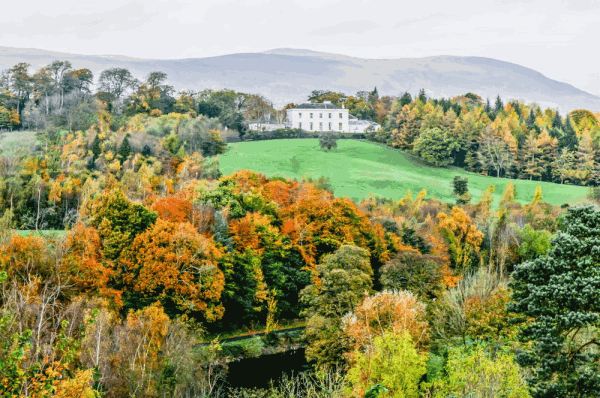
1.2.4. Trees are widely recognised for their aesthetic value. The canopy provided by urban trees offers wide-ranging, pleasant, sensorial stimuli enjoyed with seasonal change. However, the value of urban trees shouldn’t be exclusively narrowed down to ornamental considerations. Trees are key features in the urban landscape. They can give a human scale to streets lined with tall buildings. They can also soften transitions between disparate spaces, as well as creating different atmospheres, while helping to hide or emphasise views or architectural features as required. Trees are essential allies for staging and highlighting the positive traits of any townscape.
1.2.5. Small groups of trees can form distinctive and well-known local landmarks. Even where there is just one mature tree, this too can have a very high landscape value. Young trees are also important as these will become the visually significant or specimen trees of the future.
2 Policy context
2.1 Regional planning policy and guidance
Regional Development Strategy (RDS) 2035
2.1.1 The Regional Development Strategy (RDS) provides regional guidance (RG) under the three sustainable development themes of Economy, Society and Environment. RG11 recognises the importance of conserving, protecting and, where possible, enhance our natural environment. It also stipulates the importance of protecting and encouraging green and blue infrastructure within urban areas.
Strategic Planning Policy Statement (SPPS) for Northern Ireland (2015)
2.1.2. The Strategic Planning Policy Statement (SPPS) identifies core principles to assist with plan-making and decision taking. Under the ‘Preserving and Improving the Built and Natural Environment’ core principle the SPPS recognises the importance of the environment and the policy also indicates the benefits the local environment can provide. Safeguarding our unique landscape and biological diversity also makes an important contribution to the protection of the wider global ecosystem. It is therefore critical that the natural environment in both urban and rural settings are preserved and improved for the enjoyment and benefit of future generations.
2.1.3. The SPPS also recognises the importance of sustainable development and the importance of ensuring and linking future development to local communities whilst conforming to the plan-led system. The policy conveys that planning permission shall not be granted which would result in the unacceptable adverse impact on, or damage to natural heritage features worthy of protection, including trees and woodlands.
2.2 Local planning policy
Plan Strategy
2.2.1. The LDP Plan Strategy (PS) provides the strategic policy framework for the plan area as a whole across a range of topics. It sets out the vision for Belfast as well as the objectives and strategic policies required to deliver that vision. It also includes a suite of topic-based operational policies, including those relating to trees and development.
2.2.2 Policy TRE1 – Seeks to protect existing trees and to encourage more trees to be planted in the city. This recognises the important role that existing trees and new tree planting play in biodiversity, as well as their role in mitigation and adaptation to environmental change, building greater city resilience. Policy TRE1 seeks to promote the protection of trees and encourage further provision of trees by:
- Applying a precautionary approach to the net loss of trees.
- Protecting trees from harm caused by development.
- Encouraging the incorporation of trees in the design process; and
- Requiring tree planting as part of new development proposals.
TRE1 - Trees
The council will seek to protect existing trees from new development particularly those that are of visual, biodiversity or amenity quality and significance, and there will be a presumption in favour of retaining and safeguarding trees that make a valuable contribution to the environment and amenity. The council will adopt the precautionary principle when considering the impacts of a proposed development on trees of visual, biodiversity or amenity quality and significance.
We will also seek to secure a net gain in tree numbers as a result of built development, in the interests of natural heritage, amenity, environmental quality and resilience. All proposals for new built development should seek to provide for additional tree planting appropriate to the nature, scale and location of the development.
Where the loss of trees is unavoidable, proposals must include provision for replacement planting and other mitigation works on-site or, in exceptional circumstances, at an appropriate location in the immediate vicinity.
2.2.3. Policy DES2 (point J) – Masterplanning also highlights the importance for trees in designing sites. The retention of existing trees within and around the site should be a key design criterion, with the provision to allow existing trees to mature whilst also ensuring the continuance of tree cover through new tree planting. This in essence, helps to retain the local character and promote visual amenity values for future generations to enjoy. Other policies in the Plan Strategy also seek the protection of trees and promotion of additional planting, as part of a wider network of green and blue infrastructure.
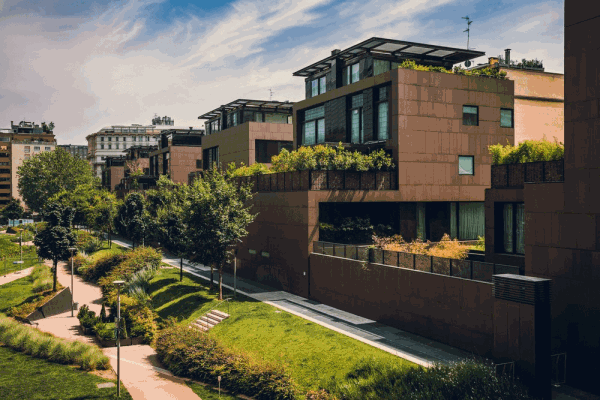
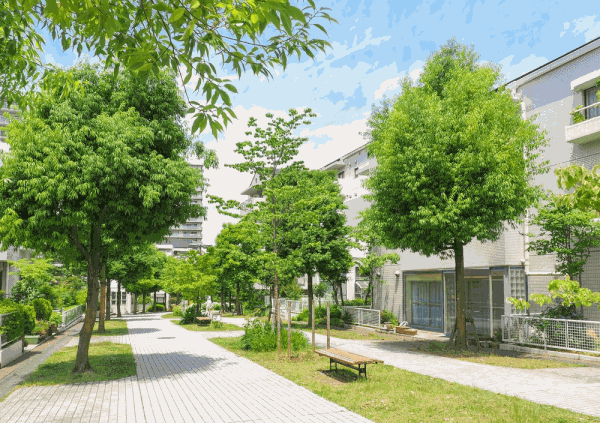
Local Policies Plan
2.2.4. The Local Policies Plan (LPP) will set out proposals in relation to the development and use of land in Belfast, including site-specific proposals, designations and land use zonings required to deliver the Council’s vision, objectives and strategic policies, as set out in the Plan Strategy. The LPP will set out key site requirements for certain zoned sites, which may include specific guidance in relation to trees and landscape.
Belfast Agenda
2.2.5. One of the key outcomes for the Belfast Agenda, the city’s community plan, is to create a vibrant, attractive, well-connected, and environmentally sustainable city. Trees and landscaping can contribute to achieving these outcomes both in terms of protecting existing trees and establishment of new planting across the city in all forms, street trees, private trees, feature trees, parks and woodlands. The document also highlights a key objective to seek a sustainable approach in protecting and improving the city’s natural and built environment.
Green and Blue Infrastructure Plan (GBIP) and Belfast Open Spaces Strategy (BOSS)
2.2.6. The Green and Blue Infrastructure Plan (GBIP) and Belfast Open Spaces Strategy (BOSS) cover the period 2019 to 2035. The GBIP aims to ensure that vegetated areas (the green) and waterways (blue infrastructure) are planned strategically to maximise economic, social, and environmental benefits in and around the conurbation’s urban areas. The BOSS aims to protect, develop, and improve access to good-quality open spaces to improve health and well-being, support urban wildlife and biodiversity, and encourage investment.
2.2.7. The council also supports other environmental and climate resilience projects, including the One Million Trees project, which seek to deliver tree planting as a proactive method to green the city for the benefit of all.
3. Protect, promote and preserve
3.1 Ownership and responsibility
3.1.1 The city council owns and manages a large number of trees across the city, ranging from trees in local parks to the zoo. The Council is also responsible for the management of a large number of street trees on behalf of the Department for Infrastructure. With regards private trees, there is a duty of care to manage and maintain those trees in a safe manner, it is the responsibility of the tree owner to take reasonable care to avoid acts or omissions which he or she could reasonably foresee may result in harm or injury.
Statutory control is exercised using Tree Preservation Orders (TPOs) and by attaching conditions to planning permissions. There is also a legislative requirement to control proposed tree works to trees in the designated conservation areas across the city. For further information see the Council’s separate guidance on Tree Preservation Order and Trees in Conservation Areas: A Guide to Protected Trees: Tree preservation orders
3.1.2. In terms of ownership and responsibility, there is a civic duty for all citizens to help in ensure trees continue to play a key role as urban areas develop in the future. Social demand for city trees is at an all-time high; trees, woodlands and urban greenways are now seen as quintessential to, and inseparable from quality of life the people of cities aspire to achieve and expect in city future planning.
3.2 Designing sites with trees
3.2.1 Sites for development can come in a wide variety of sizes and shapes, often with differing levels and other constraints within the site. Sites can be greenfield or brownfield and there may be a number of features, including the following:
- Existing trees and landscaping,
- Existing or proposed trees within the site; and
- Trees on boundaries or adjoining lands.
When designing a site for future development, it is vital to ‘front-load’ the design requirement stage. Emphasis should be placed on retaining existing trees within new development.
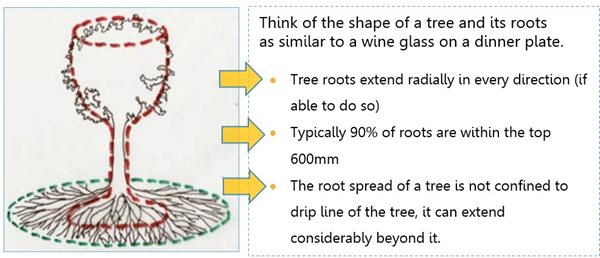
3.2.2 Important site design considerations:
- Existing trees – be aware of existing tree species, tree location(s), height, crown spread, rooting area, existing site levels, condition and potential for future tree growth in height and spread in conjunction with achieving future enjoyable amenity space for site users.
- Tree protection during construction – the design of a development should mitigate any potential negative impacts to trees, woodlands and hedgerows during the construction phase; access requirements, tree protection fencing, ground protection (ground guards, geocell), proposed levels, underground apparatus and storage areas.
- Proposed trees and landscaping – the function of the proposed planting – feature tree, street tree, garden tree, correct tree for suitable locations, established height and crown spread, future management, adequate spacing and planting size density, and presentation.
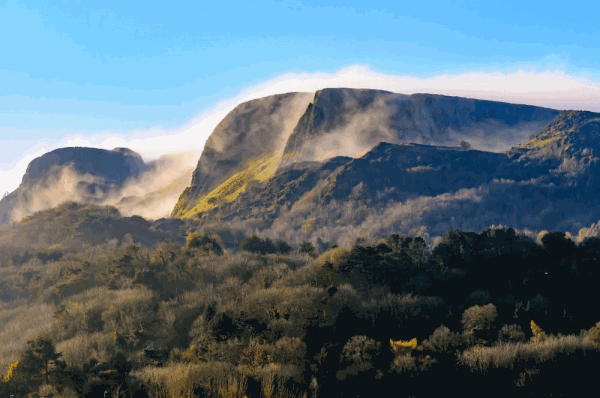
3.2.3. Existing trees are an important factor on construction sites, with associated works often exerting pressure on trees. The objective when developing sites should be to try and achieve a harmonious relationship between trees and structures that promotes long term sustainability.
3.3 Tree protection measures
3.3.1. Sites that have trees on the site, or within proximity, require careful design measures and further assessment as part of the planning /construction process:
- Tree survey – categorise trees and clarify species, Root Protection Area (RPA) (based on trunk diameter measured at 1.5m above ground), crown spread (N, S, E, W) size (in metres), root protection area (RPA), health, condition (as per BS: 5837: 2012 (A, B, C or U), remaining life expectancy, age recommendations, observations, corresponding map with details of crown spread and RPA indicated.
- Tree protection plan – a plan that indicates trees for retention, removal and receive tree surgery, precise location of protective fencing areas (see 6.2 – barriers and ground protection BS:5837:2012), extent and type of ground protection (ground guards /geocells etc), location of underground services / connections, site access (incl. temporary), all proposed structures shall be indicated on the plan, car parking area, special construction techniques (e.g. bridging / pile and beam), ground level changes, site huts, soil mounds and storage. If the site is confined in terms of size, a Construction Management Plan may be asked to be submitted.
- Arboriculturist Impact Assessment - identifies, evaluates, and mitigates where appropriate the extent of direct and indirect impacts on existing trees that may arise as a result of any site layout proposal
- Arboricultural Method Statement Report – fully details what tree protection measures are needed for all stages of the proposed development, using current best practice and requirements of BS5837:2012 Trees in Relation to Construction - recommendations.
- Utilities - It is often necessary for trenches to be dug to install utilities such as electricity, gas and water to properties, or to carry out maintenance on existing services. Due to limited space, below ground utilities are often installed close to tree roots. Damage to tree roots can be avoided if contractors carry out any works adjacent to trees in accordance with best industry practice as stated in BS5837:2012 Trees in relation to design, demolition and construction – Recommendations National Joint Utilities Group (NJUG) Guidelines for the Planning, Installation and Maintenance of Utility Apparatus in Proximity of Trees
3.3.2. Examples of good and bad tree protection during construction
- Correct type of fencing (robust) around the edge of the RPA, the area inside the RPA shall be considered sacrosanct during all site works.
- Ground protection can be used temporary or long term to avoid soil and root / soil compaction on existing trees.
- Pre-construction may be required to enable machinery to safety manoeuvre onto and within the site – details to be provided at planning stage.
3.3.3. Typical damage to trees consists of: Root loss or damage due to strip excavation. Soil compaction caused by driving or storing materials on soil. Root suffocation from the addition of fill / soil – change in levels. Drought stress or drowning because of changes in irrigation or drainage. Bark injury or branch breakage caused by vehicles, supplies or equipment. Overpruning to accommodate new structures.
Raising levels around the trunk and RPA can result in the decline of the tree and should be avoided. ©Barrell Tree Consultancy.
3.3.4. Design ideas:
- Support structures using post, pads, piles and pier construction or discontinuous footings to preserve structural roots.
- Use geotextile fabric / grasscrete instead of compacting soil and on a temporary basis to assist with site construction.
- Retain levels within RPAs of trees to be retained.
- Innovative and creative with regards to engineering.
- Root barriers may act as future proofing
- Monitor works in RPAs by employing a supervising arboriculturist
- Excavation in RPAs should be with handheld tools, preference would be to use air tools as they are effective at exposing roots and services with minimal damage.
Successful tree preservation requires a group effort. The most well-intentioned design can still fail to preserve trees if the building techniques are not also tree-friendly. Always seek advice from a professional arboriculturist.
4. Design with trees and landscaping
4.1. Urban design elements
4.1.1 Trees are integral to the urban design of any city or town - they provide huge array of benefits for society. Given the desire for urban living along with the growing importance of green infrastructure, it is vital to understand how to properly design for trees, and the monetary value trees contribute to their local environment.
Planting a liability or growing an asset?
4.1.2. The planting of trees should respect and enhance the amenity of an area, reinforcing its character and appeal, for example Fagus Sylvatica (beech) trees have strong historical links to the Minnowburn area within South Belfast. Trees can help break up and visually soften a streetscape / arterial route contributing to the character of the local area, as can be seen on the Falls Road.
4.1.3. Trees should always aim to form part of the overall townscape context and different planting may be appropriate for a public garden, feature space, public square, open space and parks compared to a residential street. ‘Garden trees’ do not necessarily make good ‘street trees’ – crown shape, established height and spread, clear stems and rooting systems are just some considerations to think about when proposing planting species.
4.1.4. It is essential that the right species of tree is selected for a particular site and environment. Species should normally be planted in positions which allow the tree to grow to maturity without inhibition of form. In addition to consideration of enjoyable amenity, species selection should encourage biodiversity.
4.1.5. Although the varied benefits of trees might not always be understood individually, people still perceive trees overall as making places more attractive, whether at a town or neighbourhood level. The size and diversity of parks and woodlands is one of the main criteria used to assess urban landscape character and environmental quality.
4.2 Tree shape examples
4.2.1 Trees are living organisms, they come in a wide variety of species which makes them ideal for an array of environments, whether it be for decorative garden trees, feature trees within a public space in a residential development or to aid with screening and privacy. There are some fundamentals in deciding a tree species to consider for individual or site requirements for example be aware of the species established height and crown spreads. This is particularly important in consideration of adjacent ‘targets’ or proposed ‘targets’ in the future, buildings, pathways, private amenity areas, vehicles etc. Will the tree suit and integrate within the context of the site? Further details should be sought from a professional in the landscaping sector such as an Arborist, Landscape Architect, Landscape Designer and a Tree Officer.
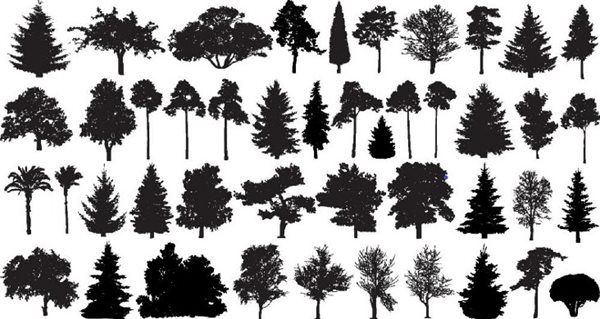
4.2.2 Design for sustainability and green infrastructure is a key theme emerging from the LDP, therefore, choose native big trees where there is sufficient space to establish, and multiple species to promote future resilience and biosecurity. There are also opportunities to plant non-native trees which helps create planting diversity and a sense of character within local contexts – genetic strength in wide mix planting is encouraged. Most epidemics are species specific, generally they will only affect one type of tree. Therefore concentrating many trees of the same species in the same area greatly increases biosecurity risks. By contrast, natural environments with diverse species are better equipped to withstand epidemics.
Amenity distance: Securing Space for Existing and New Trees
4.2.3. In terms of site development, it is critical to plan and design while accounting for trees that are existing on a site, and locations of proposed trees in order to achieve effective amenity distance within the site (and also for neighbouring landowners).
4.2.4. Amenity distance should provide adequate space to enable a harmonious relationship between site users, structures and trees which can be sustained in the long term without causing concern or a public safety issue.
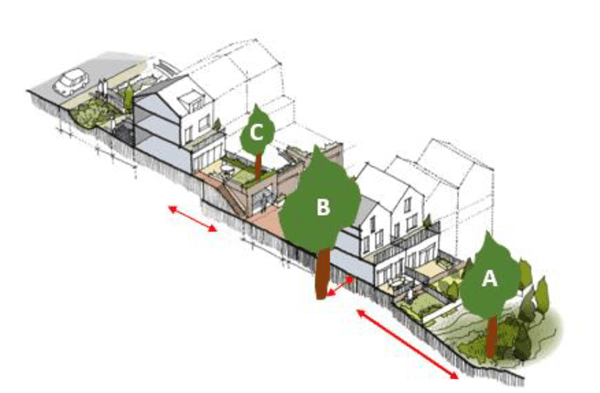
- Be aware of the tree species and the potential for growth in height and crown spread, shading and tree surgery
- Maintenance & Management costs.
- Amenity distance is taken from the edge of the crown spread or edge of RPA (whichever is greater).
- As a rule of thumb / guidance;
- 3m for a side elevation
- 6m for a front /rear elevation
- For heavier and more shading tree species, such as beech, lime, oak and chestnut it is recommended that the distance is further increased to help safety accommodate amenity provisions.
4.2.5. Refer to the above diagram, and note the locations and heights of tree A, tree B and tree C within the residential scenario.
- Tree A – sited on lower ground, the tree has potential for growth, therefore, will require future tree management – at present would be appropriate.
- Tree B – the tree is significant in height and crown spread, the tree would be too close to the side elevation, the tree has the ability for further growth – the tree is causing a concern.
- Tree C- the tree has been planted within a rear garden, the tree is an acceptable in height and spread, and is not causing concerns to the site or adjacent properties and considered to be an appropriate species choice.
4.2.6. If trees are existing and well established, development proposals should avoid seeking to build in close proximity to the trees. This ensures that the trees can continue to provide an enjoyable, useable amenity space and also ensures that there is a sufficient area for the trees (and their potential for growth) to co-exist in a safe, sustainable manner.
4.3 Tree planting sizes
Tree sizes can be rather deceptive and so it is important to have some measurements to hand if you don’t want to underestimate or overestimate the size of trees you require for your project. With tree planting within a planning application context, the normal practice is to plant a tree of extra heavy standard in size or above to help contribute to the site - more details are available:
| Specification: | Girth: | Planting Height: |
|---|---|---|
| Light Standard | 6-8cm | 1.5m - 2.5m |
| Standard (S) | 8-10cm | 2.0m - 3.0m |
| Select Standard | 10-12cm | 2.5m - 3.5m |
| Heavy Standard | 12-14cm | 3.0m - 4.0m |
| Extra Heavy Standard | 14-16cm | 3.5m – 4.75m |
| Semi-Mature | 20cm + | 4.5m + |
When submitting proposed landscaping details, ensure the following details are provided:
- Tree species
- Planting locations
- Planting size (EHS)
- Girth (cm)
- Planting height (m)
4.3.1 When designing landscaping schemes, whether the scheme is for a minor or major planning application, it is important to allow the planted species sufficient space to establish and develop, as opposed to tightly packed planting which will result in future problems (suppressed growth, weak structures and distorted trees).
4.3.2. When planting trees, think about the space around the tree to allow for trunk and root growth and be aware of adjacent ground surfaces – will they encourage or inhibit the tree to establish and fully form and offer future amenity value. The photo shows grass verges utilised to help allow trees establish in a safe manner, and also act as a pleasant natural buffers.
BS 8545 (2014) Trees: from nursery to independence in the landscape – Recommendations – document to assist in planning, designing, resourcing, producing, planting, and managing new trees in the landscape. It describes a process for planting young trees that will result in them achieving 'independence in the landscape' and promote healthy trees with every chance of survival.
4.3.3. Development providing for a small number of well-spaced, large species, long-lived trees in a wide, continuous, soft landscape is preferred to that providing for larger numbers of small, short-lived trees in narrow planters, hard landscape, or leftover space.
4.3.4 Planting layouts should be designed at the same time as - not after the imposition - of constraints such as:
- Visibility splays
- CCTV
- Street lighting
- Road infrastructure
- Drainage infrastructure
- Service strips / corridors
- Underground services
4.3.5. Design for a hierarchy of different types of planting including avenue planting, trees in gardens, boundary planting and open space planting.
4.3.6. Trees and landscaping can be effective ways of enhancing a site to create improved character, integrating a site into the surrounding context and also enhancing the monetary value of a site.
4.3.7. Trees and landscaping can be planted in a wide variety of locations across the city. Prior to planting it is advised to research the urban setting and type of tree that would suit the specific terrain. An example in Belfast of an entry being ‘greened’ up with apply trees, planters and herbs growing in guttering.
A back alleyway in Belfast – flags removed and replaced with apple trees
Pleached trees used to aid garden privacy and trees used to soften a blank façade.
“Right tree, right place » is the basic principle for planting design. In a context in which the available space for planting is limited and heavily constrained, species diversity offers great advantages.
4.4 Sustainability, Green Infrastructure and Innovation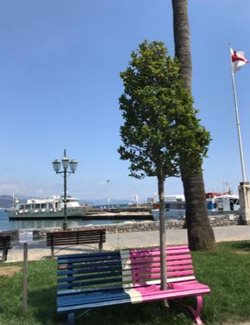
4.4.1. Belfast has a key focus to provide vital green infrastructure across the city – the Blue and Green Infrastructure Plan (GBIP) shows how green infrastructure has many environmental and socio-economic benefits. Abundant tree planting will play a key role, providing attractive green leafy routes along streets, squares and parks, to encourage walking and cycling and social interaction. The benefits of this are multiple: improving safety, physical and mental health, and helping to protect and create new wildlife habitat.
4.4.2 LDP Policy ENV3 – Adapting to environmental change focusses on green infrastructure and green design as ways to adapt to climate change, to help protect communities, biodiversity, and the built and natural environment. There is a need to change the mind-set in society to show that these types of future sustainable developments are vital as the city aims to grow in a prosperous way with environmental gains.
4.4.3. Trees are essential to manage and recycle rainwater in urban areas. In highly impermeable built-up areas, trees help alleviate the pressure on the drainage or sewer systems by intercepting rain with their leaves and branches. Where soil sealing is low, trees are also very helpful in delaying water release into soils, thus maximising infiltration and reducing the risk of soil erosion. Strategies to generalise the adoption of sustainable drainage systems (SuDS) in urban environments should therefore be designed and implemented hand in hand with the local approach to urban trees. A separate SPG on SuDS has been prepared and provides further detail.
A new residential design – sustainable tree pits and sustainable raised planters utilised acting as street flooding intervention schemes
Trees play a critical role in managing surface water runoffs and enhancing biodiversity. Lyon, France. © TDAG
4.4.4. The distinctive characteristic of trees recommended for SuDS is that they are at least moderately tolerant to both waterlogging and drought.
4.4.5. When planning and designing development sites and considering installing trees to act and assist with SuDS on site it is important to ‘front-load’ and pre-plan. This could be done through a PAD application process, outlining the locations, the type of tree / landscape and SuDS scheme to enable all consultees to be fully aware. By pre-planning it helps plan out and mitigate any potential hurdles. Retro-fitting trees to help act as SuDS can at times prove more difficult, especially as there may be restricted space under the surface to correctly install the requirements for an effective and efficient SuDS scheme.
4.4.6. The most basic method of trees acting as natural SuDS schemes is simply to plant more trees, especially in upland areas which over time will help play a role in helping prevent flooding, and slow the flow in areas which have been prone in lowland areas of the city.
4.4.7. Some tree species are more appropriate for use in SuDS schemes than other types of species Before deciding a species to plant, it is advised to consult with a professional arboriculturist or landscape architect / designer.
In designing SuDS it is important from the start to try and achieve a multi-faceted approach in which aspects can be correctly designed and engineered for long term environmental gain.
4.4.8. Sustainability and Innovation: New design within urban areas is now aiming to become more sustainable in terms of building design, aiming to create innovative ways of adding trees and landscaping to developments whether it be a green roof, a green wall or bio-retention tree pits.
4.4.9. As space for trees and other plants in urban environments reduces, roofs and façades are often the best way to bring back a natural balance. Roof gardens create space for greenery in urban areas. Roof gardens and green façades also make a significant contribution to capturing particulates, enhancing ecology, and reducing the Urban Heat Island effect. It is important to make a carefully considered choice for species that lend themselves to use on roofs. Matters such as watering systems and substrates also need to be taken directly into account in the planting plan. The deeper the substrate the taller a tree will grow. Therefore, the substrate depth can control a tree height. To hold the trees in place they should be anchored and braced to prevent wind-throw. Consult an arborist for specialist advice.
Trees at roof level to encourage rooftop gardens and social spaces
5. Management and Maintenance
5.1.1. Landscape management and maintenance plans aim to identify the true value of landscaping within a site: its amenity value and social and aesthetic qualities, which enables rationalising and quantifying its contribution over other development demands. Management plans may be subject to planning conditions.
5.1.2. The advantages of having a landscape management and maintenance plan are:
- Assessment of key landscape components and their value to your facility;
- Who is responsible for future maintenance and management with clear defects liability timeframes.
- Identification of budget and resources requirements over set timeframes;
- Strategic review of how to achieve best value in landscape management and grounds maintenance procurement;
- Demonstrate and communicate duty of care;
- Set key performance indicators measured against known targets;
- Emphasise key landscape and ecological management principles, applying a practical and holistic approaches to habitats, protected species, chemical use and appropriate tree surgery / grass cutting in all grounds maintenance tasks.
5.1.3. Like humans, trees need a lot more care when they are younger, especially when newly planted. They will need regular watering and pruning to ensure growth and structural integrity while they grow.
So what does a basic plan look like?
5.1.4. It is important to submit the correct details within the management and maintenance plans, the following details should be included:
- Identify landscape features on site; existing and proposed trees, hedging, grass, open spaces, maintenance strips
- Describe the purpose of the plan
- Watering plan
- Pruning schedule - Depending on the age of the tree, the pruning schedule will differ. The time frames are not hard and fast rules as all trees grow at different rates and require formative pruning more regularly than others. The table on the next page is a good guide if the trees do not need pruning beforehand due to encroaching on buildings or walkways.
- Monitor and review – when will inspections be carried out.
5.1.5 Clear objectives need to be established before you prune. These objectives might change from one prune to another and should be clearly stated before you start.
| Tree age | Frequency | Common objectives |
|---|---|---|
| 5 years | annually | Structural, train to single leader |
| 5 – 15 years | 2 – 5 years | Structural, Clearance, thinning |
| 15 – 25 years | 5 years | Thin, deadwood, clearance |
| 25 years + | 5 – 8 years | Dead, dying, diseased & defective branches. |
6 Appendices
6.1. Example of Tree Survey Report
| Tree No. |
Species (common name) |
Age class | Height | Crown spread | Crown clearance |
Stem diameter |
Vigour | Amenity | Water demand NHBC |
Condition and Comments | Recommendations | Ret. Cat. (sub cat.) | RPA (m) |
|||
|---|---|---|---|---|---|---|---|---|---|---|---|---|---|---|---|---|
| N | E | S | W | |||||||||||||
| T1 | Sorbus aucuparia [Rowan] |
mature | 11 | 2.5 | 3.5 | 3.5 | 4.5 | 2 | 340 | normal | moderate | moderate | Good/fair | no works required | B [1) | 4 |
| T2 | Prunus 'Kanzan' [ornamental Cherry] |
mature | 7 | 3 | 2 | 3 | 3 | 2 | 145 | normal | moderate | moderate | Fair - past branch failure | no works required | C [1) | 2.5 |
| T3 | Prunus avium cv. [Wild Cherry cultivar] |
mature | 11 | 5 | 6.4 | 5 | 5.8 | 2.5 | 710g1 | normal | high | moderate | Fair - twin stems from base with potentially weak union /previously crown reduced / surface roots south side causing damage to footpath | consider removal | C [1] | 6 |
| T4 | Cercis siliquastrum [Judas tree] |
mature | 5.5 | 2 | 2 | 2 | 1 | 2 | 240 | normal | low | low | Fair - biased crown of poor form / basal stem decay |
no works required | C [1) | 3 |
| TS | Magnolia hypoleuca [Japanese Magnolia] | mature | 5.5 | 2 | 1.5 | 2 | 2.5 | 2.5 | 220 | normal | moderate/low | low | previously crown reduced | no works required | C [1) | 2.5 |
| T6 | Platanus x hispanica [London Plane] |
mature | 24 | 10.5 | 6.5 | 5.5 | 11 | 10 | 875 | normal | high | moderate | Good - located in adjoining public park / previously reduced on south side |
no works required | A [1] | 10.5 |
| Aesculus x carnea [Red Horse Chestnut] |
middle- aged |
9 | 5 | 2.5 | 5 | 6 | 5 | 280 | normal | moderate/low | moderate | Fair - located in adjoining public park / heavily pruned east side / large stem wound at 1m |
no works required | C [1) | 3.5 | |
6.2. Types of Tree Surgery and phrases
6.2.1. In terms of proposed tree surgery it is important to clarify why the specific tree surgery is sought that will help enable informed recommendations and decision-making.
Crown reduction: Crown Reduction is where you bring an overall shape to the crown of the tree. Crown reduction is one of the common techniques used today in pruning trees. This is where you cut the foliage from the outer edge into the crown, reducing the overall shape and size of the tree. It reduces the weight of the tree and can potentially prevent limbs becoming dangerous and snapping in adverse weather conditions.
Reduction in end weight: Length and volume of over-extended stems and branches can be reduced to help alleviate excess leverage and weight of the stem and loading on its parent stem. These works can be used to help rebalance a tree which is a heavier one-sided crown shape.
Crown lift or crown raise: Crown lifting is carried out to increase the clearance between the ground level and the lower branches either to allow access below the tree, to clear sight lines, improve views or allow light to penetrate to the ground, or allow safe pedestrian or vehicular passage. Raising the canopy on trees with large diameter low branches can initiate trunk decay if these large branches are removed, it is preferable to remove secondary branches in this case.
Crown thinning: Crown Thinning involves removing a number of secondary branches in such a way that it produces a balanced crown structure, without altering the overall size or shape of the tree. It results in improved light levels passing through the canopy thus reducing shading. It reduces the sail effect of the crown and also reduces the wind loading upon the limbs of the tree. It is mainly applied to broadleaf trees.
(https://www.trees.org.uk/Help-Advice/Public/A-brief-guide-to-tree-work-terminology-and-definit)
Formative pruning: The main aim of formative pruning is to produce a tree which in maturity will be free from any major physical weaknesses and will complement the management objectives for the site.
Epicormic growth: New growth arising from dormant or new buds directly from main branches/stems or trunks
Callus: Trees attempt to close wounds naturally by forming callus tissue, undifferentiated tissue initiated as a result of wounding and which become specialised tissues of the repair over time
Cavity: A void within the solid structure of the tree, normally associated with decay or deterioration of the woody tissues. May be dry or hold water if the latter it should not be drained.
Crown: The tree crown is the top part of the tree, which features branches that grow out from the main trunk and support the various leaves used for photosynthesis.
Deadwood: Non-living branches or stems due to natural ageing or external influences. Deadwood provides essential habitats and its management should aim to leave as much as possible, shortening or removing only those that pose a risk. Durability and retention of deadwood will vary by tree species.
Dieback: Tips of branches exhibit no signs of life due to age or external influences. Decline may progress, stabilise or reverse as the tree adapts to its new situation.
Pollard: The initial removal of the top of a young tree at a prescribed height to encourage multi-stem branching from that point, traditionally for fodder, firewood or poles. Once started, it should be repeated on a cyclical basis always retaining the initial pollard point. Some species can handle a pollard such as limes, other species it is not recommended such as beech.
Bracing: Bracing is a term used to describe the installation of cables, ropes and/or belts to reduce the probability of failure of one or more parts of the tree structure due to weakened elements under excessive movement.
The importance of correct pruning cuts: Every pruning cut inflicts a wound on the tree. The ability of a tree to withstand a wound and maintain healthy growth is greatly affected by the pruning cut – its size, angle and position relative to the retained parts of the tree.
6.3. Tree ID in Autumn / Winter months
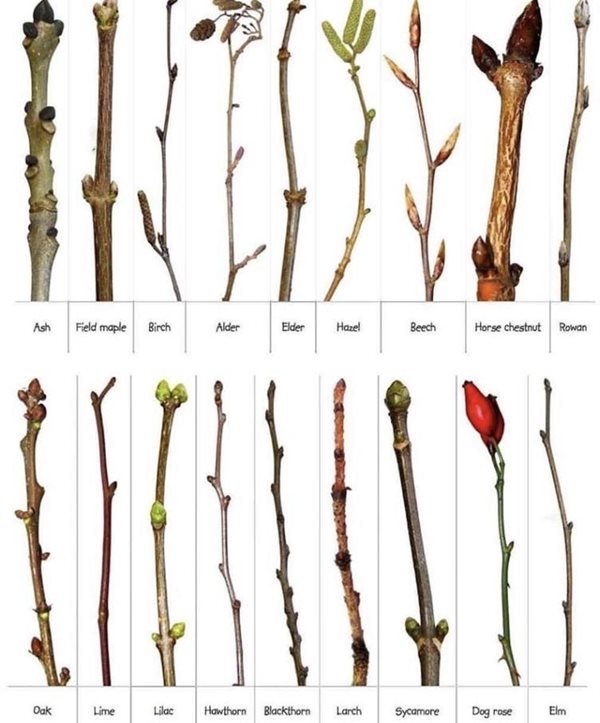
6.4. Tree Protection Plan Example:
N.B. – It is vital to allow construction working space between the edge of the tree protective fencing areas and the proposed build for the erection of scaffolding, installations, temporary access, temporary construction paths / tracks etc. which should not impact upon the canopy or root protection areas of trees in proximity to be retained.
6.5. References and further reading
- BS 8545:2014 Trees: from nursery to independence in the landscape -Recommendations
- BS 3998: 2010 Tree Work - Recommendations
- BS 5837: 2012 Trees in relation to design, demolition, and construction – Recommendations
- Trees in the Townscape: A Guide for Decision Makers – TDAG
- Trees in Hard Landscapes: A Guide for Delivery – TDAG
- Tree Species Selection (or Green Infrastructure: A Guide for Specifiers) – TDAG
- NJUG Guidelines for the Planning, Installation and Maintenance of Utility Apparatus in Proximity to Trees
- Streets for a Healthy Life: A companion guide to Building for a Healthy Life – TDAG
- Green and blue infrastructure plan - Belfast City Council
- Barrell Tree Consultancy: Site Guidance Notes (link opens in new window)
- The Arboricultural Association help and advice (link opens in new window)
- Streets for a Healthy Life: A companion guide to Building for a Healthy Life
